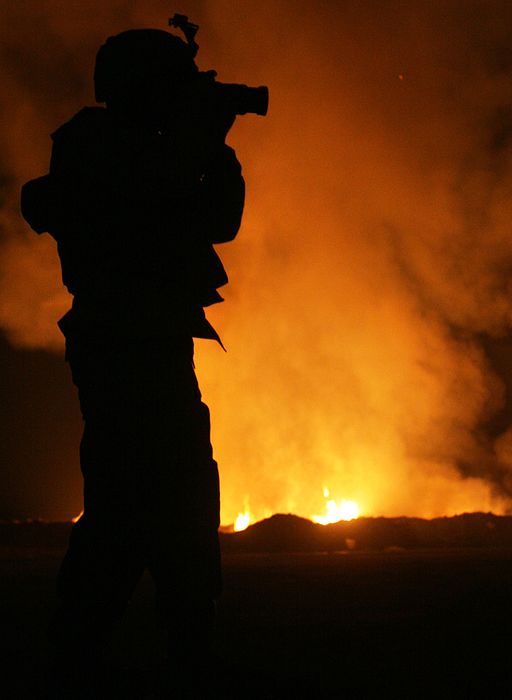VA Disability Claims based on OIF & OEF Service: burn pit and other hazardous exposures

Numerous environmental hazards exist that are specific only to Post-911 service in Iraq and/or Afghanistan. These include, but may not be limited to the following: (1) large open air burn pits throughout Iraq, Afghanistan, and Djibouti; (2) ultra-fine particulate matter (PM); (3) a large sulfur fire at Mishraq State Sulfur Mine near Mosul, Iraq; and (4) hexavalent chromium exposure at the Qarmat Ali Water Treatment Plant in Basrah, Iraq. It is imperative that veterans are aware of these environmental health hazards and informed on filing disability claims based on such exposures.
It is important to note that VA has no regulations on claims based on these exposures. However, they do have mandatory instruction on how to adjudicate such claims. VA first issued these instructions in VBA Training Letter 10-03. The mandates of that Training Letter are now incorporated into VA’s M21-1 Operating Manual. A description of these exposures is below.
Burn Pit exposure:
From approximately 2001 to the present, very large burn pits have been utilized for waste disposal at nearly all OEF/OIF military operating bases. The most well-known was the burn pit at Joint Base Balad (LSA Anaconda). The amount of solid waste burned at Balad was originally about 2 tons per day in the early stages. It then increased to several hundred tons per day in the later stages of deployment. The burn pit occupied approximately 20 acres at its peak and burned every conceivable waste product, such as: plastics, Styrofoam, and metal; rubber; chemicals (such as, paints, solvents); petroleum products and other lubricants; unexploded ordnance; industrial, medical and human waste; and other incomplete combustion by-products.
Air sampling at multiple locations in theatre detected all of the following: (1) Particulate matter; (2) numerous Polycyclic Aromatic Hydrocarbons; (3) numerous Volatile Organic Compounds; and (4) and numerous Toxic Organic Halogenated Dioxins and Furans (dioxins). The synergistic effects of exposure to such a multitude of toxins are thus far unknown to science.
Particulate matter (PM):
PM is a mixture of small particles and liquid droplets made up of a number of compounds, including acids (such as nitrates and sulfates), organic chemicals, metals, and soil/dust particles. Two sizes of particles are a health concern—those with a diameter of 10 microns (PM10) or smaller and those with a diameter of 2.5 microns (PM2.5) and smaller. Particle size is linked to potential health problems, the smaller particles being more harmful. PM10 sized or smaller are the particles that generally pass through the nose and throat and enter the lungs.
Most studies relate PM exposure to respiratory and cardiopulmonary disabilities in susceptible population subgroups, especially those with existing asthma or cardiopulmonary disease. DoD collected numerous air samples in theatre throughout the course of the War and assessed for PM. The heaviest measured concentration of PM levels were magnitudes over 1,000 ug/m3 of PM10 sized particles—far above exposure guidelines.
Sulfur Fire:
In June 2003, a fire ignited at the Mishraq State Sulfur Mine in northern Iraq. This was the largest sulfur mine in the world. It burned for 3-4 weeks and released roughly 42 million pounds of sulfur dioxide (SO2) per day; hydrogen sulfide (H2S) was also released. Sampling data collected by DOD and anecdotal reports of odors and irritation suggest levels of SO2/H2S were not solely located in the immediate vicinity of the fire. Satellite imagery showed the smoke plume reaching at least 50km north to the Mosul Airfield. DOD estimates that thousands of troops were within the 50km radius from the sulfur fire to the Mosul airfield.
Sulfur dioxide and hydrogen sulfide gases produce irritation/reddening of the nose and throat, eye irritation, and coughing. Sulfur dioxide burns the skin, causes airway obstruction, hypoxemia, pulmonary edema, and death. Many service members have long-term respiratory conditions such as constrictive bronchiolitis. However, subsequent studies have now shown that troops not exposed to the sulfur fire, but with known burn pit exposure also suffer from constrictive bronchiolitis.
Constrictive bronchiolitis is an inflammatory and fibrotic lesion of the terminal bronchioles of the lungs. It is very uncommon, but is associated with inhalation exposures. People with constrictive bronchiolitis typically have shortness of breath on exertion, but may have normal X-rays and inconclusive pulmonary function testing. Symptoms of constrictive bronchiolitis may be wrongly attributed to asthma or chronic obstructive pulmonary disease (COPD). Because of this, VA has been advised to utilize extra-scheduler ratings in cases when there is evidence that a veteran’s employment is affected. Unfortunately, VA raters rarely comply with this instruction.
Hexavalent chromium:
From approximately April through September of 2003, Army National Guard personnel from Indiana, West Virginia, South Carolina, and Oregon served at the Qarmat Ali Water Treatment Plant in Basrah, Iraq, and were assigned to guard contract workers who were restoring the plant. During that time, sodium dichromate, a source of hexavalent chromium, was found on the ground and in the air.
Hexavalent chromium, or Chromium VI, in sodium dichromate is a lung carcinogen. Chromium VI is also an acidic compound that causes immediate irritation to the eyes, nose, sinuses, lungs, and skin. Roughly 137 service members were evaluated once exposure was realized. The results showed abnormalities in individuals, such as complaints of eye, nose, throat and/or lung irritation, or abnormal pulmonary function, kidney, or liver tests.
Note:
It is important to understand that claims based on these exposures are not the same as claims under the Persian Gulf War (PGW) regulations. Claims based on the PGW regulations are granted, if at all, on a legal presumption that the disability is related to service in the Gulf. Whereas, claims based on OIF/OEF exposures, such as burn pit exposure, are granted, if at all, on a direct basis (i.e., event or exposure during service; diagnosed disability; and, a medical nexus between the two.
There are times when VA is directed to apply both sets of rules. A good example is if a veteran who served in Iraq (not Afghanistan) after September 11, 2001, files a service connection claim for a disability that could satisfy the “qualifying chronic disability” requirements of 38 C.F.R. § 3.317 (general Southwest Asia Service, i.e., PGW regulations) but is also a disability that may be directly related to an exposure specific to Iraq after September 11, 2001, such as burn pits.
About the Author
Share this Post
